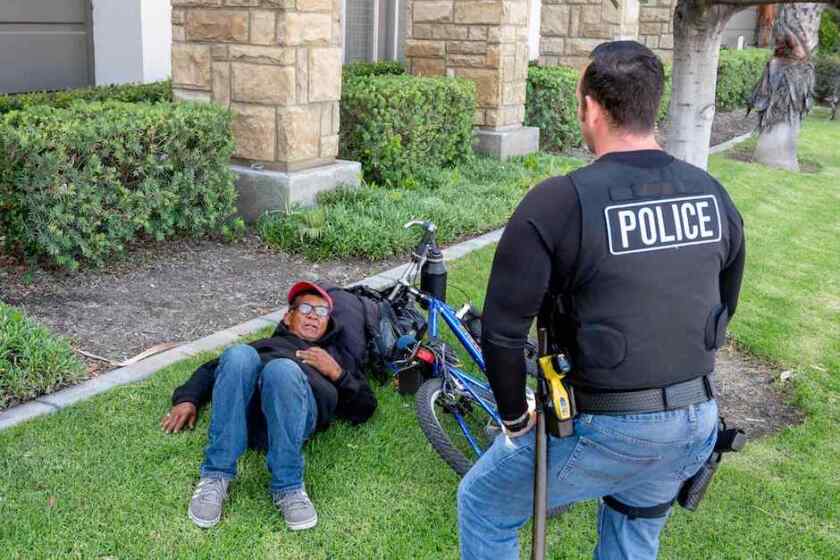In Brief:
The Supreme Court’s ruling last month in a major homelessness case may have set the stage for fines or jail time to play a greater role. So far, however, there aren’t clear signs that this is coming.
California Gov. Gavin Newsom, a Democrat, applauded the decision, saying it gives state and local officials authority “to implement and enforce policies to clear unsafe encampments from our streets.”
Tracy Avelar, the chief in Foster City and president of the California Police Chiefs Association, agrees that local governments are now better able to balance the needs of the unsheltered and the safety and quality of life concerns of the broader community. Still, Avelar says, law enforcement agencies have “no interest” in incarcerating Californians for being homeless.
Chris Hsiung, a retired California police chief and undersheriff, doesn’t expect to see police departments rounding up lots of homeless people. “My hunch is that most agencies, at least in California, will continue to try to exercise some sort of compassionate policing — but will now have legal guidance to take action if needed.”

(Paul Bersebach/TNS)
Caught in the Middle
In its 6-3 decision, the Supreme Court upheld laws enacted in Grants Pass, Ore., that ban sleeping in public places, including parks and cars. Homeless residents in the city had sued, claiming that by criminalizing the “involuntary” status of homelessness, the laws violated the Constitution’s ban on cruel and unusual punishment. The majority rejected this argument.
Derick Miller, chief of police in Irving, Texas, had been following the Grants Pass case. “I tell people all the time that being homeless is not against the law,” he says. His department has a homeless outreach team that does its best to get the unhoused to services. However, it can’t ignore calls from business owners whose entrances are being blocked. Sometimes officers do issue criminal trespass warnings in these situations, and if these are violated jail time is a possibility under Texas law.
“This is one of those societal problems that policing has been thrust in the middle of,” says Miller. “In a perfect world, the first call isn’t to the police, it’s to organizations that can help people in need.”
The International Downtown Association (IDA) filed an amicus brief supporting Grants Pass, in partnership with groups including the California Business Roundtable and the Hollywood Media District Property Owners Association. The association’s members are involved in urban place management through public-private partnerships such as business improvement districts and neighborhood associations.
“We never envisioned playing a significant role in assisting the unhoused,” says David Downey, an architect and urban design expert and the longtime president of the IDA. But increasingly, his members are involved in this type of activity, working with both nonprofits and the police to help connect the unhoused to community resources.
“IDA supported Grants Pass because we know that municipalities need all the tools they can have to address a complex situation that is unique in every city across the country,” Downey says.

(DignityMoves)
Staying Ahead of the Law
Mandy Chapman Semple was the architect of a homelessness response system in Houston that gained national attention for its success. An immediate remedy exists for the tensions that led to the Grants Pass case, she says: Local governments need to focus on quickly housing people living outside. “We know this because we are in the field everyday supporting cities to house people directly from encampments and safely close those sites,” says Chapman Semple.
Elizabeth Funk, founder of the nonprofit DignityMoves, was on the founding team for Microsoft Office and helped develop the consumer Internet while at Yahoo before she moved on to impact investing and microfinancing, including developing low-income housing in Central and South America.
At DignityMoves, Funk is working with several California cities to develop cost-effective interim housing that gets the unhoused indoors while the supply of permanent housing catches up with the demand. “People don’t vaporize — you’re going to have to have beds and places for people to go,” Funk says.
DignityMoves locates projects on borrowed land. It utilizes prefabricated modular buildings, intended to remain in place for five to 10 years. There are shared bathroom and dining facilities, following advice from services agencies that these can bring elements of risk into individual interim housing units. Shared community spaces include a computer lab.
The costs of putting these in place is less than the cost of cleaning up encampments, Funk says. “It’s cost effective and fiscally responsible,” she says. “And it’s a moral imperative.”
Could the Grants Pass decision lead to more aggressive action by law enforcement? It actually seems least likely in the states with the biggest homeless populations. There’s significant evidence that criminalization can be costly and ineffective, pulling the unhoused away from services that could improve their situation. Criminal records can cost them future opportunities for housing and employment.
“There are plenty of people experiencing homelessness in the United States who work full time, have no substance use problems, no mental health problems,” says Margot Kushel, director of the Benioff Homelessness and Housing Initiative at the University of California, San Francisco. “The public doesn’t see them because when they get into an Uber, they don’t realize that their Uber driver is sleeping in that car.”
Related Articles













